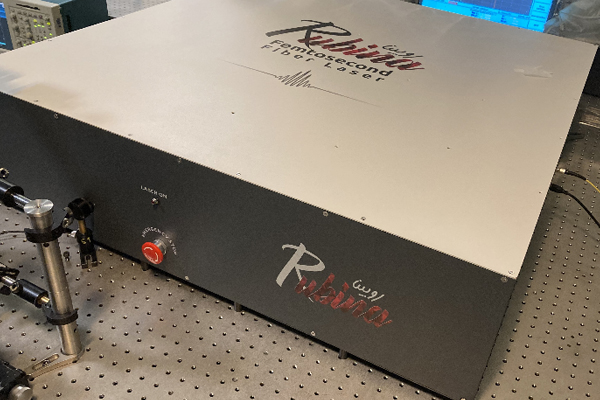
The first commercial example of a femtosecond fiber laser with the brand name Rubina-Fs-1040-5, with a wavelength of 1040 nm, a pulse length of less than 450 femtoseconds, an adjustable repetition rate of 100 kHz to one MHz, a maximum pulse energy of 5 μJ and a maximum average power of 5W was built and unveiled at the Laser and Plasma Research Institute of SBU.
This laser device is made to perform precise micromachining on the surface of and inside the materials. Micromachining with femtosecond lasers has wide applications in aviation, medical and pharmaceutical industries, etc. Especially, direct machining can be done using femtosecond lasers without the need for masks and expensive related equipment and on a specific layer of multilayer materials without affecting other layers. These lasers also provide the possibility of direct machining inside the volume of the transparent material, which is not possible by any other common machining method.
Among the applications of micromachining by femtosecond lasers, the following can be mentioned: ultra-precise drilling and cutting of metals, drilling of diesel injection nozzles, machining of cooling holes for power plant and aircraft turbine blades, manufacturing integrated optical gyroscopes (IOG) with the precision required for navigation applications, machining of explosives, cutting and separating silicon chips, micron welding of materials, manufacturing micron biomedical devices such as polymer cardiac stents, lab-on-chips, biosensors and microfluidic devices for various medical and biological applications, manufacturing microstructures on surfaces to increase the absorption of silicon materials and increase the efficiency of detectors and solar cells, creation of micron structuring on the surface of metals to reduce reflection, turn them into absorbent materials and increase surface friction, drilling and micromachining of all types of micropumps, microsensors and chemical microreactors to increase their efficiency and performance, making surgical needles, microcellular surgery, eye surgery, etc.
Conventional machining methods have many limitations for 3D geometries and different materials. However, micromachining systems with femtosecond lasers can be used for micromachining directly during a one-step process, with desired geometry without any restrictions on the geometry and without the need to produce masks and related equipment.
Another advantage of these systems is the creation of three-dimensional structures within the volume of transparent materials, which allows the construction of more complex and diverse devices. Because the refractive index changes using femtosecond lasers can be done at any point inside the sublayer material with a certain depth (100 microns to 1 mm) from the surface, this technique can create three-dimensional coupler, modulator and beam splitter structures. This is while in the conventional waveguide construction methods, there is only the possibility of constructing two-dimensional surface channels through much more complicated multi-stage processes and with more limited applications. The specifications of this laser compete well with those of similar foreign products, and to the best of our knowledge, the femtosecond laser system made with these specifications is the first commercial example of this product made in Iran. In case of more financial support and providing the required budget, it is possible to build femtosecond fiber laser devices with higher average energy and power, and thus expand their field of application.


